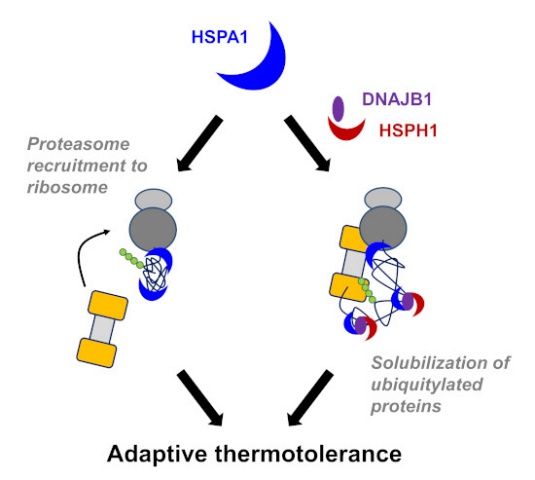Dieter A Wolf, Yabin Cheng | The EMBO Journal: Dual roles of HSP70 chaperone HSPA1 in quality control of nascent and newly synthesized proteins
How cells exposed to heat stress acquire thermotolerance is poorly understood. Here, quantitative proteomics identifies upregulation of HSP70-family chaperone HSPA1, which fulfills dual function in quality control of nascent proteins at translating ribosomes.
Proteotoxic stress causes translation arrest, ubiquitylation of nascent/newly synthesized proteins, and proteasome recruitment to ribosomes.
Proteasome recruitment to ribosomes is augmented by HSP70 activity independently of nascent chain ubiquitylation.
HSPA1 in complex with HSPH1-DNAJB1 cofactors maintains solubility and proteasomal clearance of ubiquitylated proteins.
Low HSPH1 expression impedes nascent-protein quality control and tumor growth, correlating with favorable outcome.
Exposure to heat stress triggers a well-defined acute response marked by HSF1-dependent transcriptional upregulation of heat shock proteins. Cells allowed to recover acquire thermotolerance, but this adaptation is poorly understood. By quantitative proteomics, we discovered selective upregulation of HSP70-family chaperone HSPA1 and its co-factors, HSPH1 and DNAJB1, in MCF7 breast cancer cells acquiring thermotolerance. HSPA1 was found to have dual function during heat stress response: (i) During acute stress, it promotes the recruitment of the 26S proteasome to translating ribosomes, thus poising cells for rapid protein degradation and resumption of protein synthesis upon recovery; (ii) during thermotolerance, HSPA1 together with HSPH1 maintains ubiquitylated nascent/newly synthesized proteins in a soluble state required for their efficient proteasomal clearance. Consistently, deletion of HSPH1 impedes thermotolerance and esophageal tumor growth in mice, thus providing a potential explanation for the poor prognosis of digestive tract cancers with high HSPH1 and nominating HSPH1 as a cancer drug target. We propose dual roles of HSPA1 either alone or in complex with HSPH1 and DNAJB1 in promoting quality control of nascent/newly synthesized proteins and cellular thermotolerance.
Link: https://www.embopress.org/doi/full/10.15252/embj.2020106183
